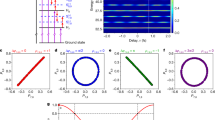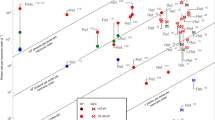Abstract
The strong-field process of high-harmonic generation is the foundation for generating isolated attosecond pulses1, which are the fastest controllable events ever induced. This coherent extreme-ultraviolet radiation has become an indispensable tool for resolving ultrafast motion in atoms and molecules2,3. Despite numerous spectacular developments in the new field of attoscience2,3,4, the low data-acquisition rates imposed by low-repetition-rate (maximum of 3 kHz) laser systems5 hamper the advancement of these sophisticated experiments. Consequently, the availability of high-repetition-rate sources will overcome a major obstacle in this young field. Here, we present the first megahertz-level source of extreme-ultraviolet continua with evidence of isolated attosecond pulses using a fibre laser-pumped optical parametric amplifier6 for high-harmonic generation at 0.6 MHz. This 200-fold increase in repetition rate will enable and promote a vast variety of new applications, such as attosecond-resolution coincidence and photoelectron spectroscopy7, or even video-rate acquisition for spatially resolved pump–probe measurements.
This is a preview of subscription content, access via your institution
Access options
Subscribe to this journal
Receive 12 print issues and online access
$209.00 per year
only $17.42 per issue
Buy this article
- Purchase on Springer Link
- Instant access to full article PDF
Prices may be subject to local taxes which are calculated during checkout





Similar content being viewed by others
References
Hentschel, M. et al. Attosecond metrology. Nature 414, 509–513 (2001).
Krausz, F. & Ivanov, M. Attosecond physics. Rev. Mod. Phys. 81, 163–234 (2009).
Sansone, G., Calegari, F. & Nisoli, M. Attosecond technology and science. IEEE J. Sel. Top. Quantum Electron. 18, 507–519 (2012).
Sansone, G., Poletto, L. & Nisoli, M. High-energy attosecond light sources. Nature Photon. 5, 655–663 (2011).
Schultze, M. et al. Powerful 170-attosecond XUV pulses generated with few-cycle laser pulses and broadband multilayer optics. New J. Phys. 9, 243 (2007).
Rothhardt, J., Demmler, S., Hädrich, S., Limpert, J. & Tünnermann, A. Octave-spanning OPCPA system delivering CEP-stable few-cycle pulses and 22 W of average power at 1 MHz repetition rate. Opt. Express 20, 10870–10878 (2012).
Neppl, S. et al. Attosecond time-resolved photoemission from core and valence states of magnesium. Phys. Rev. Lett. 109, 22–26 (2012).
Ferray, M. et al. Multiple-harmonic conversion of 1064 nm radiation in rare gases. J. Phys. B 21, L31–L35 (1988).
Corkum, P., Burnett, N. & Ivanov, M. Y. Subfemtosecond pulses. Opt. Lett. 19, 1870–1872 (1994).
Antoine, P., L'Huillier, A. & Lewenstein, M. Attosecond pulse trains using high-order harmonics. Phys. Rev. Lett. 77, 1234–1237 (1996).
Paul, P. M. et al. Observation of a train of attosecond pulses from high harmonic generation. Science 292, 1689–1692 (2001).
Baker, S. et al. Probing proton dynamics in molecules on an attosecond time scale. Science 312, 424–427 (2006).
Smirnova, O. et al. High harmonic interferometry of multi-electron dynamics in molecules. Nature 460, 972–977 (2009).
Miaja-Avila, L. et al. Direct measurement of core-level relaxation dynamics on a surface-adsorbate system. Phys. Rev. Lett. 101, 46101 (2008).
Sandberg, R. L. et al. Lensless diffractive imaging using tabletop coherent high-harmonic soft-X-ray beams. Phys. Rev. Lett. 99, 098103 (2007).
Christov, I. P., Murnane, M. M. & Kapteyn, H. C. High-harmonic generation of attosecond pulses in the ‘single-cycle' regime. Phys. Rev. Lett. 78, 1251–1254 (1997).
Baltuška, A. et al. Attosecond control of electronic processes by intense light fields. Nature 421, 611–615 (2003).
Zair, A. et al. Time-resolved measurements of high order harmonics confined by polarization gating. Appl. Phys. B 78, 869–872 (2004).
Lindner, F., Stremme, W., Schätzel, M. & Grasbon, F. High-order harmonic generation at a repetition rate of 100 kHz. Phys. Rev. A 68, 013814 (2003).
Südmeyer, T. et al. Femtosecond laser oscillators for high-field science. Nature Photon. 2, 599–604 (2008).
Gohle, C. et al. A frequency comb in the extreme ultraviolet. Nature 436, 234–237 (2005).
Henke, B. L., Gullikson, E. M. & Davis, J. C. X-ray interactions: photoabsorption, scattering, transmission, and reflection at E = 50–30,000 eV, Z = 1–92. Atom. Data Nucl. Data Tables 54, 181–342 (1993).
Salières, P., L'Huillier, A. & Lewenstein, M. Coherence control of high-order harmonics. Phys. Rev. Lett. 74, 3776–3779 (1995).
Zaïr, A. et al. Quantum path interferences in high-order harmonic generation. Phys. Rev. Lett. 100, 143902 (2008).
Nisoli, M. et al. Effects of carrier-envelope phase differences of few-optical-cycle light pulses in single-shot high-order-harmonic spectra. Phys. Rev. Lett. 91, 213905 (2003).
Sola, I. J. et al. Controlling attosecond electron dynamics by phase-stabilized polarization gating. Nature Phys. 2, 319–322 (2006).
Sansone, G., Benedetti, E., Vozzi, C., Stagira, S. & Nisoli, M. Attosecond metrology in the few-optical-cycle regime. New J. Phys. 10, 025006 (2008).
Mikkelsen, A. et al. Photoemission electron microscopy using extreme ultraviolet attosecond pulse trains. Rev. Sci. Instrum. 80, 123703 (2009).
Demmler, S. et al. Control of nonlinear spectral phase induced by ultra-broadband optical parametric amplification. Opt. Lett. 37, 3933–3935 (2012).
Iaconis, C. & Walmsley, I. A. Spectral phase interferometry for direct electric-field reconstruction of ultrashort optical pulses. Opt. Lett. 23, 792–794 (1998).
Baltuska, A. et al. Phase-controlled amplification of few-cycle laser pulses. IEEE J. Sel. Top. Quantum Electron. 9, 972–989 (2003).
Hädrich, S. et al. Improving carrier-envelope phase stability in optical parametric chirped-pulse amplifiers by control of timing jitter. Opt. Lett. 37, 4910–4912 (2012).
Brabec, T. & Krausz, F. Intense few-cycle laser fields: frontiers of nonlinear optics. Rev. Mod. Phys. 72, 545–591 (2000).
Gaarde, M. B., Tate, J. L. & Schafer, K. J. Macroscopic aspects of attosecond pulse generation. J. Phys. B 41, 132001 (2008).
Lewenstein, M. et al. Theory of high-harmonic generation by low-frequency laser fields. Phys. Rev. A 49, 2117–2132 (1994).
Acknowledgements
This work was supported by the German Federal Ministry of Education and Research (BMBF), the European Research Council under the European Union's Seventh Framework Programme (FP7/2007-2013)/ERC grant agreement no. 240460, UK-EPSRC project EP/J002348/1 and UK Royal Society project IE121529. The authors thank E. Cormier for providing initial simulations and for fruitful discussions. L.C. thanks the Imperial College High Performance Computing Service for the use of their facilities.
Author information
Authors and Affiliations
Contributions
J.L. conceived the initial idea. The experiments were planned, designed and performed by M.K., S.D., S.H. and J.R. with support from A.Z., L.C. and J.L. The experimental data were analysed by M.K. and S.H, and L.C. and A.Z. contributed the simulations and supported the interpretation of the results. J.L. and A.T. supervised the project and acquired funding. All authors contributed to the manuscript.
Corresponding author
Ethics declarations
Competing interests
The authors declare no competing financial interests.
Rights and permissions
About this article
Cite this article
Krebs, M., Hädrich, S., Demmler, S. et al. Towards isolated attosecond pulses at megahertz repetition rates. Nature Photon 7, 555–559 (2013). https://doi.org/10.1038/nphoton.2013.131
Received:
Accepted:
Published:
Issue Date:
DOI: https://doi.org/10.1038/nphoton.2013.131
This article is cited by
-
Progress on table-top isolated attosecond light sources
Nature Photonics (2022)
-
Towards attosecond imaging at the nanoscale using broadband holography-assisted coherent imaging in the extreme ultraviolet
Communications Physics (2021)
-
Spatiotemporal imaging of valence electron motion
Nature Communications (2019)
-
Highly stable Yb-fiber laser amplifier of delivering 32-μJ, 153-fs pulses at 1-MHz repetition rate
Applied Physics B (2018)
-
High-harmonic generation in amorphous solids
Nature Communications (2017)



